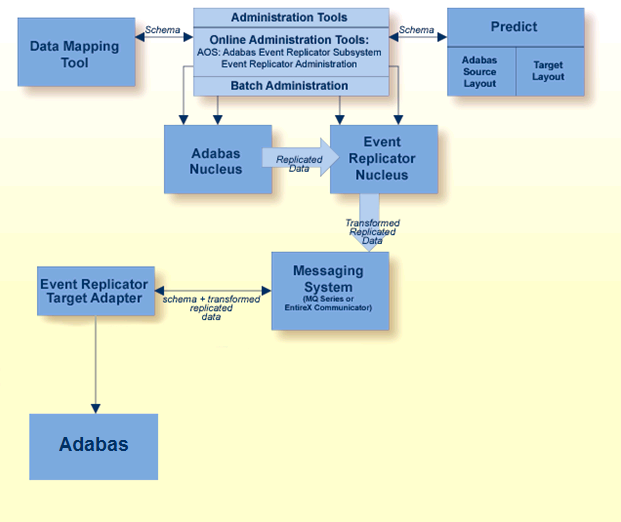You can use the Event Replicator Target Adapter to replicate data to Adabas.
The following diagram depicts the interaction between the Event Replicator Target Adapter and Adabas.

This document describes how to set up the Adabas target in the Event Replicator Target Adapter. It covers the following topics:
The Event Replicator Target Adapter uses the Adabas Client for Java internally to write the data to Adabas. See the requirements for Adabas Client for Java.
Direct replication using Adabas file short names requires Event Replicator for Adabas Version 3.7 SP1 with zap AZ371002 applied on the mainframe.
The Event Replicator Target Adapter uses Adabas Client for Java to process the data. For details about the concept, especially instructions on creating and configuring a Map File in the target database, see the section Creating Maps in the Adabas Client for Java documentation.
Depending on the user’s desired end result and configuration, there are times when a map file is required and times when it is not.
A Map File and target Map are not required when:
The Adabas source and target file numbers are the same.
Event Replicator for Adabas Version 3.7 SP1 is installed on the mainframe with zap AZ371002 applied.
The Event Replicator Destination is defined with
DCLASSPARM=NOSPRE,ADA.
The user wants the Event Replicator Target Adapter to create the target file and is not concerned if all extended field attributes are replicated when the target file is created. By default, only UQ and DE attributes are sent as defined in the GFFT, with all fields defined at the target as Null Suppressed. As a workaround to this behavior, the user can preload the target file with an FDT that fully defines the extended field attributes. The file number must still match the source database file number.
When no Map File is defined in the Adabas target definition in Event Replicator Target Adapter Administration, none will be used or created during Initial State processing. However, the requirements outlined above must be met or the Target Adapter will throw an exception and stop processing.
A Map File and target Map are required when:
The Adabas source and target file numbers are different.
The mainframe replicator configuration does not meet the requirements outlined above (e.g. short names are not being sent in the schema and replicated data).
The user desires the target file definition with specific field attributes exactly matching the source (e.g. using the same predefined FDT for file and target).
When a Map File is defined in the Adabas Target definition, a Map is always used. It can be:
Predefined using the Data Designer in Adabas Client for Java by preloading the target file with an FDT that matches the source file FDT or using a systrans’d DDM. See Creating Maps in the Adabas Client for Java documentation for details. In this case, the name of the target file and the name of the map must match and be the same as the file name of the source. The target file number need not be the same as the source file number. or
Created during the Initial State processing, thereby mapping field Long Names from the GFFT definition used by the Event Replicator for Adabas to Adabas short names in the target file "on the fly". If the target database file number that matches the source is not available, the next available file number in the target database will be used.
Note:
If the Event Replicator for Adabas is not running Version 3.7 SP1 with AZ371002
applied and with DCLASSPARM=ADA defined, the field short names on
the target side are assigned by the Target Adapter and will not necessarily
agree with those from the target.